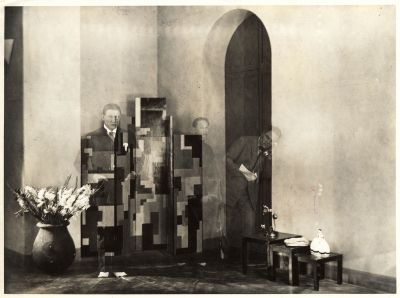
ANTOINETTE SABRIER
(Francia/1926) R.: Germaine Dulac. D.: 73'. Did. francesi
Sog.: dal testo teatrale omonimo. Scen.: Germaine Dulac. F.: Henri Stuckert, Georges Daret. Scgf.: G. Silvagni, Georges Quenu. Ass. regia: Marie-Anne Malleville. Int.: Ève Francis (Antoinette Sabrier), Gabriel Gabrio (Germain Sabrier), Jean Toulout (Jamagne), Yvette Armell (Hélène Doreuil), Paul Guidé (René Dangenne), Paul Menant (Chartrain), Maurice Cervières (Gaston Doreuil, consigliere di Mr. Sabrier), Ashida (la ballerina), Lou Davy. Prod.: Société des Cinéromans. 35mm. L.: 1517 m (l. orig.: 2300 m). D.: 66' a 20 f/s. Bn. Imbibito / Tinted. Didascalie francesi / French intertitles.Da: CNC - Archives Françaises du Film
Tami Williams presenta il suo libro Germaine Dulac: A Cinema of Sensations (University of Illinois press, 2014)
Accompagnamento al piano di Donald Sosin
Antoinette Sabrier, film commerciale e controverso pensato su misura per l'attrice Ève Francis, era tratto da una pièce di Romain Coolus, la cui opera era stata recensita nel 1908 da Dulac, allora giovane critica teatrale. È la storia di una donna bellissima, indipendente e sessualmente emancipata che si dibatte tra il marito magnate del petrolio (Gabriel Gabrio) e l'amante (Paul Guidé). Rappresentando con ricchezza di sfumature i compromessi tra dovere e desiderio, questo ritratto di una donna intrappolata in un matrimonio infelice con un marito che la trascura e alle prese con un amore non corrisposto potrebbe essere considerato una sorta di seguito di precedenti ritratti femminili di Dulac (la Contessa d'Amaury ne La Belle Dame sans merci, la protagonista de La Souriante Madame Beudet). Non si tratta però del semplice adattamento d'un testo teatrale. Giocando sui registri drammatici dell'atmosfera e dell'intimità, la regista sfrutta tutta una serie di tecniche cinematografiche come il montaggio e la ripresa al rallentatore per "descrivere attraverso i ritmi esteriori" - come le pulsazioni erotiche di una trivella petrolifera o i gesti armoniosi di una danza - "i ritmi interiori delle emozioni". Come aveva già fatto per La Folie des vaillants, anche qui Dulac girò vari finali: uno più consono alla conclusione della pièce originale e un altro, sollecitato dai distributori, più conservatore. Del film esistono varie versioni: in una copia destinata a un pubblico cattolico mancano le scene più festose e il finale meno convenzionale, mentre nella versione più esuberante del film figura una magnifica festa con costumi e scenografie orientaleggianti e una strabiliante scena di harakiri che prefigura la crisi del marito. La seconda versione è quella proposta in questa rassegna.
Based on a play by Romain Coolus, whose work Dulac reviewed as a young theater critic in 1908, her commercial and controversial Ève Francis vehicle, Antoinette Sabrier, is the tale of a beautiful, independent, and sexually liberated woman, torn between her oil-baron husband (Gabriel Gabrio) and her lover (Paul Guidé). A nuanced portrayal of the negotiation of duty and desire, this portrait of a woman trapped in an unhappy marriage to an inattentive husband, and deprived of an unrequited love might be seen as an unofficial sequel to Dulac's earlier feminine portraits (Countess d'Amaury in La Belle Dame sans merci, the heroine of La Souriante Madame Beudet). However, it is not a simple theatrical adaptation. Playing on the dramatic registers of both atmosphere and human intimacy, Dulac employs a variety of cinematic techniques such as slow motion and editing to "describe through external rhythms", such as the erotic pulsations of an industrial oil rig, or the harmonious gestures of dance, "the inner rhythms of character emotions". As she had done for La Folie des vaillants, Dulac also shot multiple endings for the film, one in keeping with the suicidal ending of the original play, as well as another more conservative ending solicited by distributors. Multiple copies of the film exist: while the most festive scenes and original ending are cut from a Catholic edition, the most colorful version of the film features a beautiful fête with oriental costumes, decors, and a startling harakiri performance prefiguring the husband's crisis. This latter is featured here.
seguono
CEUX QUI NE S'EN FONT PAS
(Francia/1930) R.: Germaine Dulac. D.: 6'. V. francese
Scen.: Germaine Dulac. Prod.: Isis Films. Musiche registrate / Records: Si j'étais chef de gare, Maurice Yvain/André Barde, Columbia 1928; Sur le pont d'Avignon, Columbia 1928 (da BNF). 35mm. L.: 133 m. D.: 6' a 20 f/s. Bn. Versione francese / French version. Da: CNC - Archives Françaises du Film
CELLES QUI S'EN FONT
(Francia/1930) R.: Germaine Dulac. D.: 6'. V. francese
Scen.: Germaine Dulac. F.: Jean Jouannetaud. Int.: Lilian Constantini, Georges Vallée. Prod.: Isis Films. Musiche registrate / Records: Toute Seule, Parlophone 1928, voce: Fréhel; A la dérive, Pathé 1927, voce: Germaine Lix (da BNF). 35mm. L.: 130 m. D.: 6' a 18 f/s. Bn. Versione francese / French version. Da: Lobster Films.
Restaurato da / Restored by Lobster Films e Ripley's Film
AMÉRIQUE. ENREGISTREMENT DE SENSATIONNELLES MANOEUVRES
(Francia/1933) D.: 1'
PARIS. EPREUVE NAUTIQUE
(Francia/1934) D.: 2'
LE BAL DE LA TSF ET SES ATTRACTIONS À PARIS
(Man Lifting Man, Francia/1934)
PARIS. MISTINGUETTE EN TOURNÉE D'UNE TROUPE D'ÉLITE, MÈNE LA REVUE DES FOLIES BERGÈRES
(Francia/1933) D.: 1'
CÔTE D'AZUR. UN COUP D'OEIL INDISCRET SUR QUELQUES VEDETTES
(Francia/1934) D.: 1'
FRANCE. LES PARISIENS CÉLÈBRENT À LEUR TOUR LA FÊTE NATIONALE DU 14 JUILLET (BAL POPULAIRE)
(Francia/1934) D.: 2'
24 HEURES DANS LA CASE DU "COUSIN TOM" OU LA VIE DES NÈGRES À PARIS
(Francia/1933) D.: 1'
PARIS LES FEMMES MANIFESTENT AUSSI PUISQU'ELLES PAIENT DES IMPÔTS
(Francia/1933) D.: 4'
INTERVIEW CHARLES DELAC SUR LA LIBERTÉ DE LA PRESSE FILMÉE
(Francia/1935) D.: 1'
PARIS LA CÉLÈBRE CHANTEUSE RÉALISTE FREHEL DANS UNE DE SES DERNIÈRES CRÉATIONS. AKA PARIS. FRANCE. "JE N'ATTENDS PLUS RIEN."
(Francia/1934) D.: 4'

Tariffe:

Numero posti: 174
Aria Condizionata
Accesso e servizi per disabili
Il nostro cinema aderisce al circuito CinemAmico: è possibile utilizzare l’applicazione MovieReading® per i film di cui è prevista audiodescrizione e/o sottotitolazione sull'applicazione.
Tel. 051 2195311











